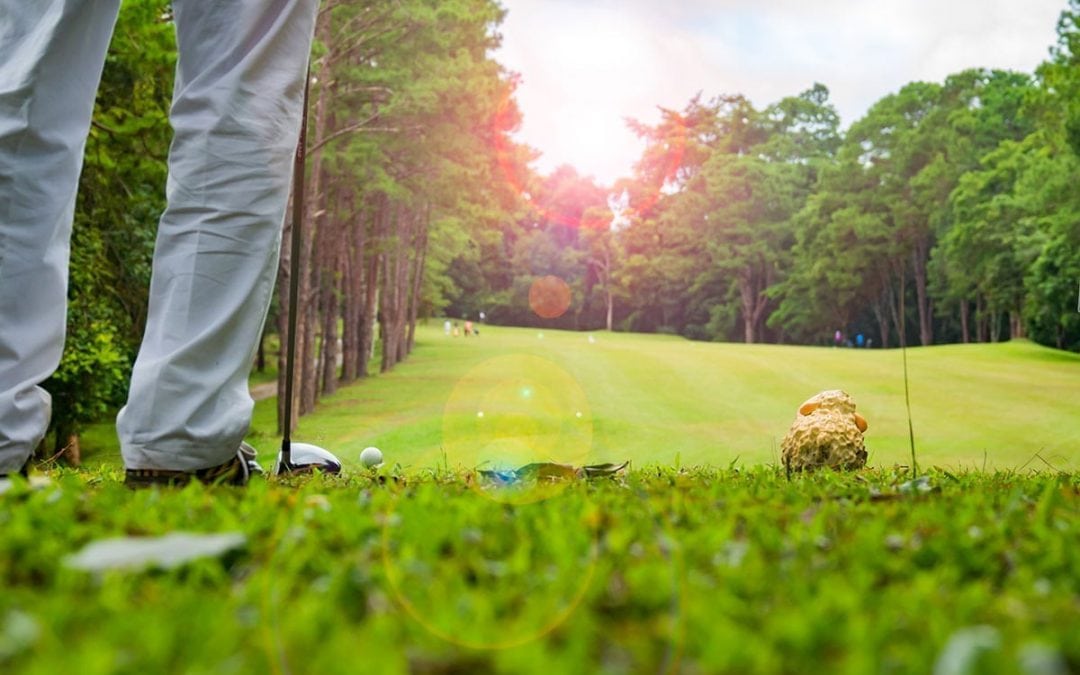Do you know this feeling?
You are able to start to play an important round of golf while feeling super calm, confident, peaceful, and in control. It’s magical and your ball striking can be really good, but it can come on one of those poor-ball-striking days too. Somehow nothing seems to bother you as you still find a way to score. If you are like most competitive golfers, this awesome feeling has at some time come upon you during your play. And, like most, you probably have some difficulty explaining just how or why it came about when it did. No tip will completely prevent those days from happening, but one way to stop this from occurring most of the time is by practicing presence. Being present in golf is an aspect of your mental state of mind that you can address yourself, and it will lead to incredible results on the course.
It’s Your Choice.
Which would you rather do?
- Wait for one of those magical rounds or days when everything “clicks” and mentally you are peaceful, resilient and playing out of your mind?
- Be pro-active and learn to put yourself there, especially when you most want to play well?
Which do you think Tiger does? Or Dustin Johnson?
Elite golfers like Tiger and DJ place high importance on, and are extremely pro-active at practicing being present. As a result, it may well be the very best of their many great golfing skills.
Quite consciously, Tiger puts himself into a place mentally that allows him to get the very most from his game on any given day. So much so that he can win a PGA event while in a “slump” or a major championship while in extreme pain.
With this skill, you too can free yourself to get the very most from your game on any given day, facing any type of challenge.
Learn to Be Present in Golf
One of the key differences between the “average golfer” and the “champion golfer” is that the champion is not involved with the irrelevant, and is peacefully involved with what is.
It’s as though the game of golf was created to perfectly test your ability and willingness to truly be “present.”
A key tip for golf is to remember the countless things that tug, pull and distract you from being “present” while playing the game. At the same time, the pace of play, the beauty of the course, the wildlife and nature surrounding you, and the quiet peacefulness of play itself provides you a great environment for learning to be “present.”
What does it mean to “Be Present”?
Being present in golf simply means being in the moment. Said another way, it is being enveloped in, and fully aware of, what you are doing at the moment you are in.
The concept of being present in golf means there is less “DOING” to play better, and more “LETTING” yourself play better.
The average golfer is almost always too involved with his round, struggling between “past”, “future” and “judging.”
What percent of your thoughts during your last round were involved with:
- The Past.
…mistakes you made, putts you missed, opportunities that you lost, how poorly you have played in the last hour or the last year, etc. - The Future.
…how you will play holes ahead, how you will compare to the field, how you will finish, where you might lose strokes, how your scores will look to others, what a win would do for you, etc. - Judging.
…thinking about how to hit a shot, analyzing why a shot was missed, criticizing yourself or your play, reacting to good or bad play, blaming your caddy, comparing yourself to others, mind-reading others thoughts, etc.
The higher your percentage of time spent thinking on these type of things, the more you need to work on being present when you play.
What does Being Present in Golf do for your game?
Just watch vintage Tiger.
His tremendous ability to be present, which is heavily influenced by his Buddhist religion and his continued practice of mindful meditation, allows him the discipline and ability to play golf immersed in the the process of simply playing shots, one at a time, without the mental clutter of past, future or judging.
“Tida [Tiger’s Mother] was meant …to introduce Tiger to Buddhism and inner peace…” – Earl Woods
Being Present in Golf Takes On-Going Practice
Being Present is not something players are born with, not even Tiger. It’s a mindset we need to learn and perfect over a lifetime of practice. It is easier to be present when we are children, when we are less concerned about about past, future, and judging. It is easier for some adults who are more naturally able to do the same.
But to maintain and strengthen this skill we must remain aware of its importance and remain aware of conquering our own individual challenges to being present.
For Tiger, by his own estimation, this involved conquering what he calls innate “stubbornness and impatience.” He had to master and control a powerful desire to make something happen right now.
With guidance and great personal commitment, he came to pursue his goals with patience and presence. He learned to immerse himself completely in the simple things he could control, maintaining complete trust that his intended results would come.
His aim, with his mindful meditation, is to maintain the ability to achieve on cue the calm, intense focus that he has become so famous for.
Have you noticed that slightly different “look” he takes on when he competes? It’s as if he is entering another special world that is all his own, where nothing can bother him. In a sense, he is in a different world. To get there he has learned to purposely take his attention from the outer world and immerse himself in a powerful, peaceful inner world before going to the first tee.
As Earl Woods was quoted as saying, “Tiger is the best at both worlds” which can be interpreted to mean he is superior at managing both his outer and his inner worlds when he plays.
This does not mean he is perfect. Even Tiger is known to be bothered by a rude photographer snapping away in his back swing. But imagine how practiced being present he must be to be leading the final round of the Masters and be surprised to find himself out of holes on the 18th green.
Confirm the Power of Being Present Yourself
You can confirm the power of being present yourself by asking a few players about their all time best rounds, or by reflecting on your own. You will hear a theme of presence in almost all the descriptions.
You will hear things like:
- I really was not even that aware of my score or where I stood that day.
- It was all so easy, I was just hitting shots and finding them.
- Nothing bothered or distracted me.
- I was so into what I was doing I could see and feel the shots and putts before I hit them.
With practice and intention, you too can improve your ability to be present.
Here are a few tips to keep in mind before you begin
- Start small with moments and minutes and slowly increase into larger periods of time.
- Make learning to be present a progressive, persistent and life-long goal.
- Start now and look for opportunities to practice being present in most everything you do, both on and off the course.
So how do you learn to Be Present?
There are many, many techniques you can use to learn to be present in golf. Some of the most common ones among our most successful clients include prayer, music, yoga, martial arts, breathing exercises, fishing, playing with children and pets, positive imagery, and the use of some of the countless books and tapes on the subject.
We know you are curious so we will briefly explain how to use Tiger’s method of mindful meditation. It is a particularly great one because it is easy to learn and use and because it has so many positive uses in golf and in your life.
Mindfulness: A Method for Being Present
Mindfulness involves bringing your awareness back from the past, or future and irrelevant judging to now. It is an activity that can be done at any time and it does not require sitting or lying down, unless of course you choose to practice this way.
Mindfulness is accomplished by bringing the mind to focus on what is happening in the present moment, while simply noticing the mind’s usual commentary.
Examples:
You can be mindful of:
- the firmness or softness of the earth beneath your feet while walking down the fairway,
- the whispering sound of the wind in the trees,
- or the warmth of the sun on your skin.
Your mind’s commentary related to these things:
- “I wish these fairways were not so soft –I cannot get any distance. I have already lost strokes on easy holes and I have got to play better to have any chance today.”
- “Why does the wind have to blow now! I have not hit a fairway all day and the back 9 is even tougher.”
- “I will be so glad when this round is over and I get out of this heat. I play terrible in hot weather and I hate hitting out of all these shadows.”
Look at these thoughts again to see if you can recognize the elements of past, future and judging.
Once you gain notice of your own mind’s running commentary, you now have the freedom to cease identification with those judgments and perceptions. And change them to productive, peaceful, Present thoughts that will power your play:
- “I enjoy the softness of the fairway under my feet, and appreciate the lie it gives, and the ability to pick and stick my targets.”
- “The wind is my friend; I feel, embrace and work with it to create great shots. The wind is my reminder to keep great tempo and rhythm in my swing and stroke.”
- “I let the warmth and the sun relax and energize me, fuel me with great focus. I look through the shadows to clearly see the shots and putts I want to hit.”
Take time daily to practice checking your own mental commentary. If you deem it “past”, “future” or “judging” take a moment to then practice changing the commentary to a more present, peaceful and productive thought.
Keys to Mindfulness in Golf
Any activity done mindfully is a form of being present. Mindfulness is possible at practically any time you choose to practice it. Even doing routine tasks that you may dislike, such as laundry, washing dishes, flying, packing, or even going to the dentist.
Here are a few keys to help you learn to be mindful:
- Practice accepting and appreciating what each moment offers.
- Gain a greater awareness of yourself–your breathing, your thoughts, your emotions, your tension–and learn creative and personal ways for managing them.
- Resist judging yourself, comparing yourself to others, or over-analyzing what you’re going to do or say.
- Resist weighing things down with expectations, hopes, wishes, and experiences. Allow them to simply be the way they are as you focus on the simple things that you can control.
- Practice being patient with yourself and other people. Let go of impatience and fears related to things–pleasant or unpleasant–that can happen.
- Trust your first impressions and yourself more.
Use mindfulness to learn to be truly present during competition and you will be amazed at the fun, energy and improvement you gain.
Remember that being present in golf can take some time. If you’re struggling to teach yourself these methods on your own, you can gain some pointers firsthand through our weekend golf schools.


